Abstract
Transport and metabolism of [2,3-14C] 1-aminocyclopropane-1-carboxylic acid (ACC) from roots to shoots in 4-day-old sunflower (Helianthus annuus L.) seedlings were studied. [14C]ACC was detected in, and 14C2H4 was evolved from, shoots 0.5 hours after [14C]ACC was supplied to roots. Ethylene emanation from the shoots returned to normal levels after 6 hours. The roots showed a similar pattern, although at 24 hours ethylene emanation was still slightly higher than in those plants that did not receive ACC. [14C]N-malonyl-ACC (MACC) was detected in both tissues at all times sampled. [14C]MACC levels surpassed [14C]ACC levels in the shoot at 2 hours, whereas [14C]MACC levels in the root remained below [14C]ACC levels until 6 hours, after which they were higher. Thin-layer chromatography analysis identified [14C] ACC in 1-hour shoot extracts, and [14C]MACC was identified in root tissues at 1 and 12 hours after treatment. [14C]ACC and [14C] MACC in the xylem sap of treated seedlings were identified by thin-layer chromatography. Xylem transport of [14C]ACC in treated seedlings, and transport of ACC in untreated seedlings, was confirmed by gas chromatography-mass spectrometry. Some evidence for the presence of [14C]MACC in xylem sap in [14C]ACC-treated seedlings is presented. A substantial amount of radioactivity in both ACC and MACC fractions was detected leaking from the roots over 24 hours. A second radiolabeled volatile compound was trapped in a CO2-trapping solution but not in mercuric perchlorate. Levels of this compound were highest after the peak of ACC levels and before peak MACC levels in both tissues, suggesting that an alternate pathway of ACC metabolism was operating in this system.
Full text
PDF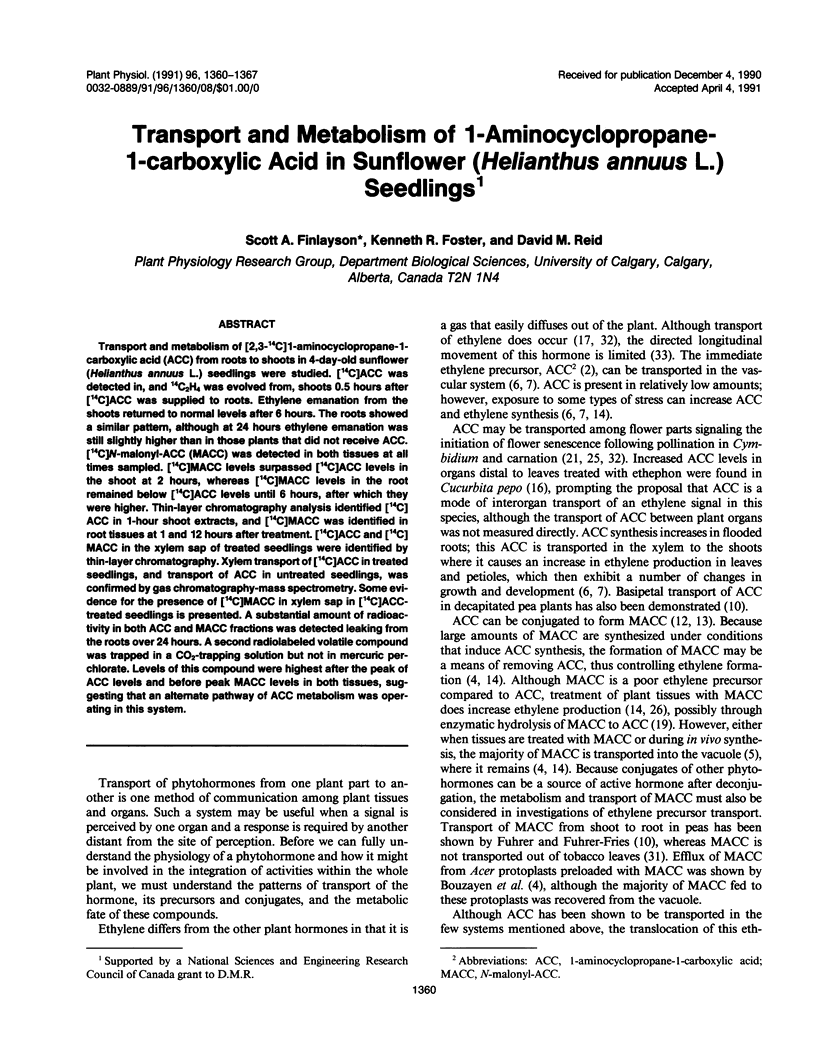
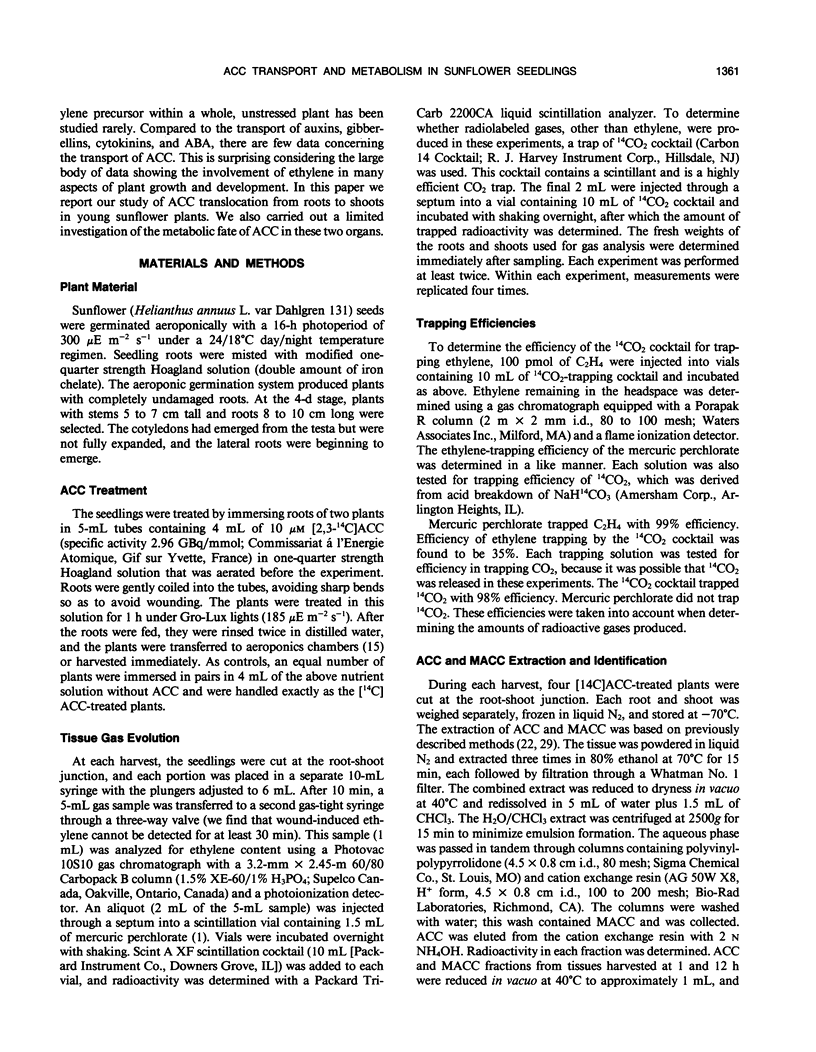
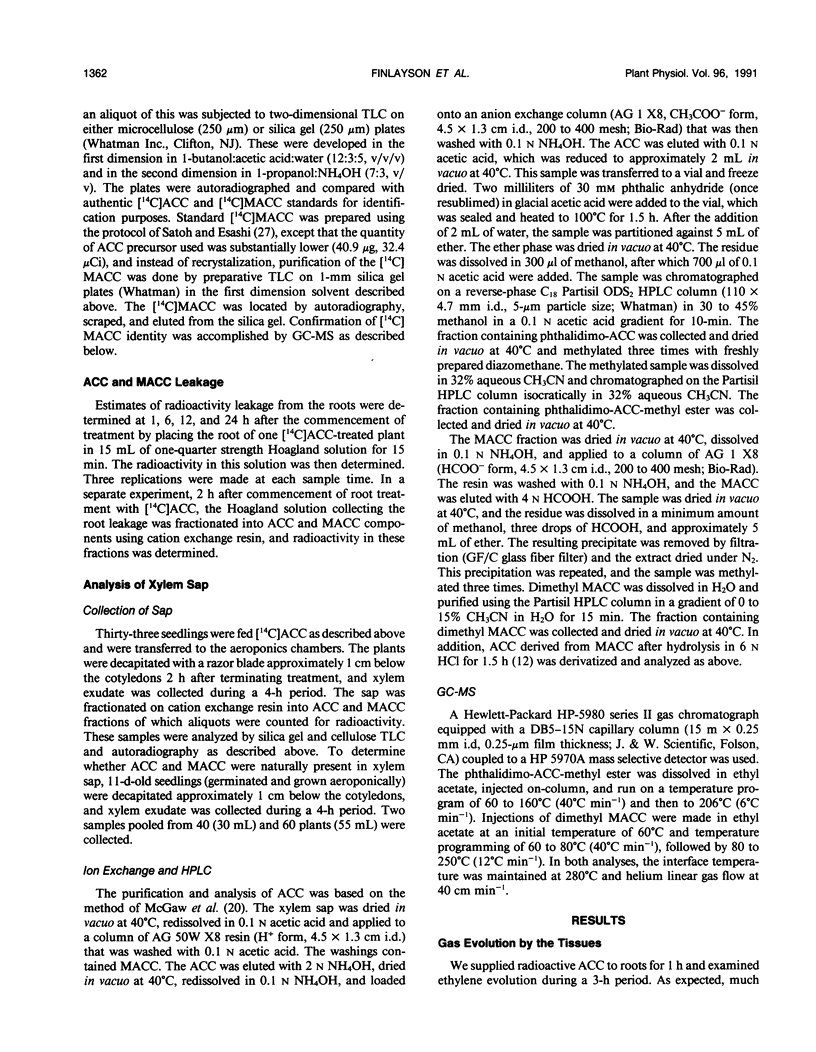
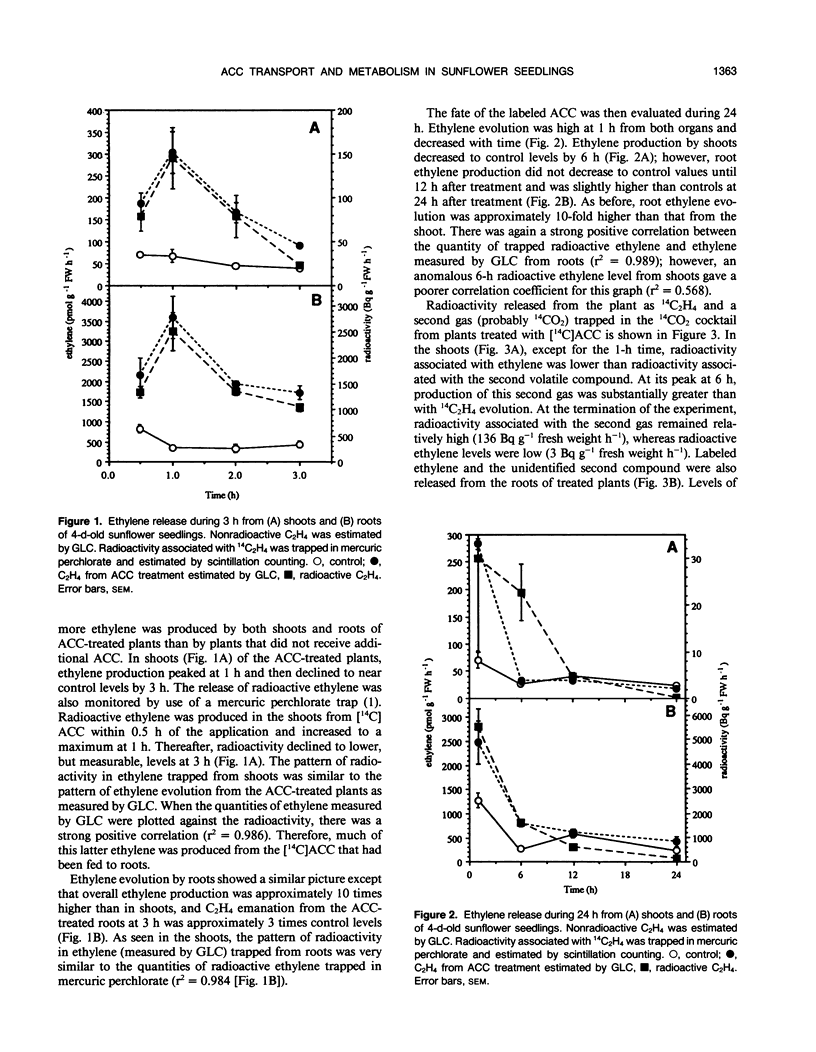
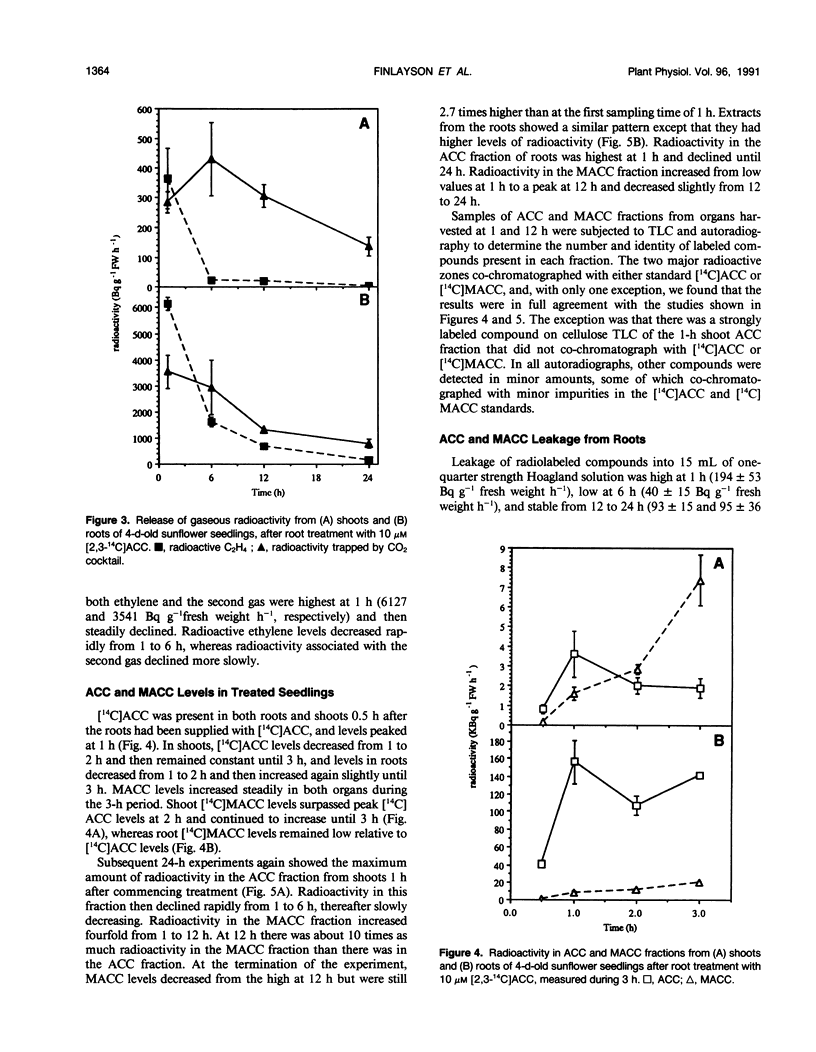

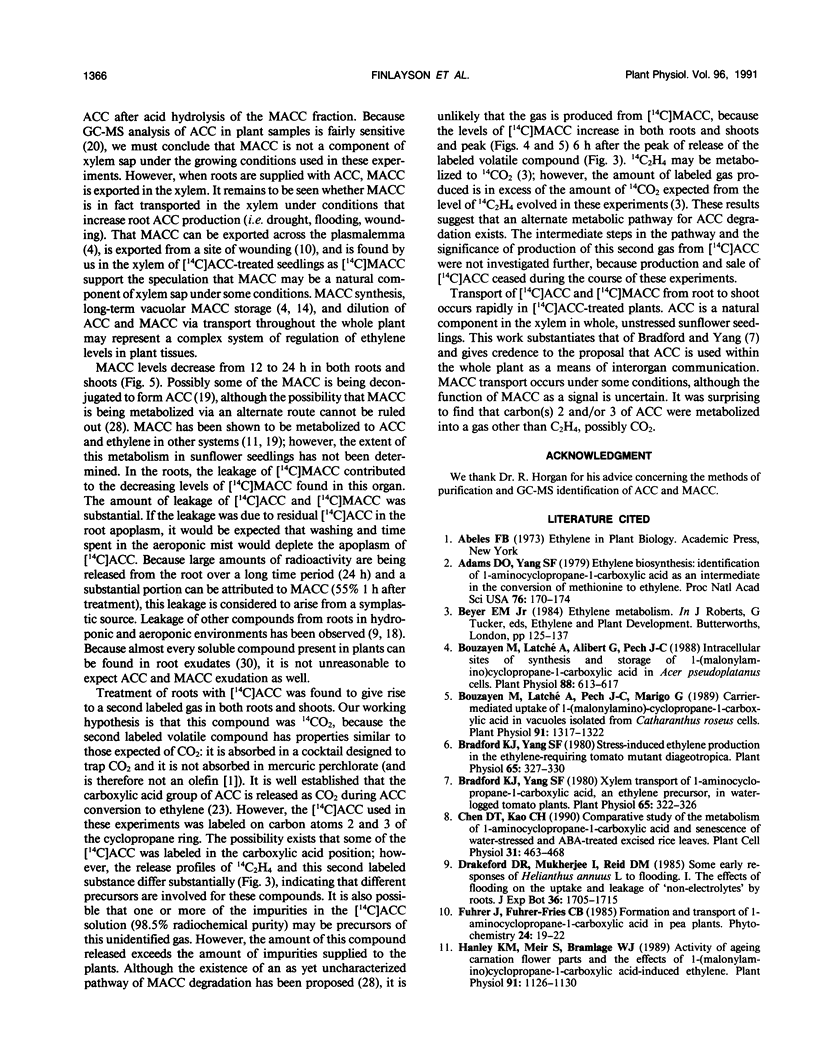
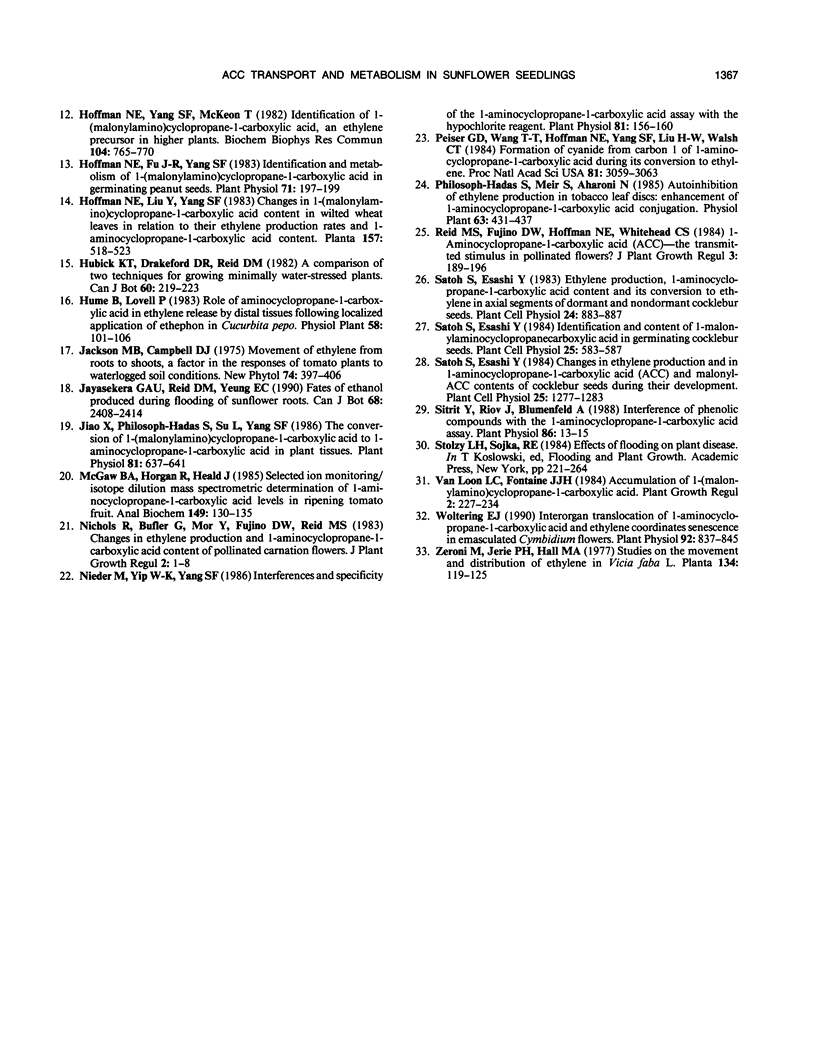
Selected References
These references are in PubMed. This may not be the complete list of references from this article.
- Adams D. O., Yang S. F. Ethylene biosynthesis: Identification of 1-aminocyclopropane-1-carboxylic acid as an intermediate in the conversion of methionine to ethylene. Proc Natl Acad Sci U S A. 1979 Jan;76(1):170–174. doi: 10.1073/pnas.76.1.170. [DOI] [PMC free article] [PubMed] [Google Scholar]
- Bouzayen M., Latché A., Alibert G., Pech J. C. Intracellular Sites of Synthesis and Storage of 1-(Malonylamino)cyclopropane-1-Carboxylic Acid in Acer pseudoplatanus Cells. Plant Physiol. 1988 Nov;88(3):613–617. doi: 10.1104/pp.88.3.613. [DOI] [PMC free article] [PubMed] [Google Scholar]
- Bouzayen M., Latché A., Pech J. C., Marigo G. Carrier-Mediated Uptake of 1-(Malonylamino)cyclopropane-1-Carboxylic Acid in Vacuoles Isolated from Catharanthus roseus Cells. Plant Physiol. 1989 Dec;91(4):1317–1322. doi: 10.1104/pp.91.4.1317. [DOI] [PMC free article] [PubMed] [Google Scholar]
- Bradford K. J., Yang S. F. Stress-induced Ethylene Production in the Ethylene-requiring Tomato Mutant Diageotropica. Plant Physiol. 1980 Feb;65(2):327–330. doi: 10.1104/pp.65.2.327. [DOI] [PMC free article] [PubMed] [Google Scholar]
- Bradford K. J., Yang S. F. Xylem Transport of 1-Aminocyclopropane-1-carboxylic Acid, an Ethylene Precursor, in Waterlogged Tomato Plants. Plant Physiol. 1980 Feb;65(2):322–326. doi: 10.1104/pp.65.2.322. [DOI] [PMC free article] [PubMed] [Google Scholar]
- Hanley K. M., Meir S., Bramlage W. J. Activity of Ageing Carnation Flower Parts and the Effects of 1-(Malonylamino)cyclopropane-1-Carboxylic Acid-Induced Ethylene. Plant Physiol. 1989 Nov;91(3):1126–1130. doi: 10.1104/pp.91.3.1126. [DOI] [PMC free article] [PubMed] [Google Scholar]
- Hoffman N. E., Fu J. R., Yang S. F. Identification and Metabolism of 1-(Malonylamino)cyclopropane-1-carboxylic Acid in Germinating Peanut Seeds. Plant Physiol. 1983 Jan;71(1):197–199. doi: 10.1104/pp.71.1.197. [DOI] [PMC free article] [PubMed] [Google Scholar]
- Hoffman N. E., Yang S. F., McKeon T. Identification of 1-(malonylamino) cyclopropane-1-carboxylic acid as a major conjugate of 1-aminocyclopropane-1-carboxylic acid, an ethylene precursor in higher plants. Biochem Biophys Res Commun. 1982 Jan 29;104(2):765–770. doi: 10.1016/0006-291x(82)90703-3. [DOI] [PubMed] [Google Scholar]
- Jiao X. Z., Philosoph-Hadas S., Su L. Y., Yang S. F. The Conversion of 1-(Malonylamino)cyclopropane-1-Carboxylic Acid to 1-Aminocyclopropane-1-Carboxylic Acid in Plant Tissues. Plant Physiol. 1986 Jun;81(2):637–641. doi: 10.1104/pp.81.2.637. [DOI] [PMC free article] [PubMed] [Google Scholar]
- McGaw B. A., Horgan R., Heald J. K. Selected ion monitoring/isotope dilution mass spectrometric determination of 1-aminocyclopropane-1-carboxylic acid levels in ripening tomato fruit. Anal Biochem. 1985 Aug 15;149(1):130–135. doi: 10.1016/0003-2697(85)90485-3. [DOI] [PubMed] [Google Scholar]
- Nieder M., Yip W. K., Yang S. F. Interferences and specificity of the 1-aminocyclopropane-1-carboxylic Acid assay with the hypochlorite reagent. Plant Physiol. 1986 May;81(1):156–160. doi: 10.1104/pp.81.1.156. [DOI] [PMC free article] [PubMed] [Google Scholar]
- Peiser G. D., Wang T. T., Hoffman N. E., Yang S. F., Liu H. W., Walsh C. T. Formation of cyanide from carbon 1 of 1-aminocyclopropane-1-carboxylic acid during its conversion to ethylene. Proc Natl Acad Sci U S A. 1984 May;81(10):3059–3063. doi: 10.1073/pnas.81.10.3059. [DOI] [PMC free article] [PubMed] [Google Scholar]
- Sitrit Y., Riov J., Blumenfeld A. Interference of phenolic compounds with the 1-aminocyclopropane-1-carboxylic Acid assay. Plant Physiol. 1988 Jan;86(1):13–15. doi: 10.1104/pp.86.1.13. [DOI] [PMC free article] [PubMed] [Google Scholar]
- Woltering E. J. Interorgan translocation of 1-aminocyclopropane-1-carboxylic Acid and ethylene coordinates senescence in emasculated cymbidium flowers. Plant Physiol. 1990 Mar;92(3):837–845. doi: 10.1104/pp.92.3.837. [DOI] [PMC free article] [PubMed] [Google Scholar]


